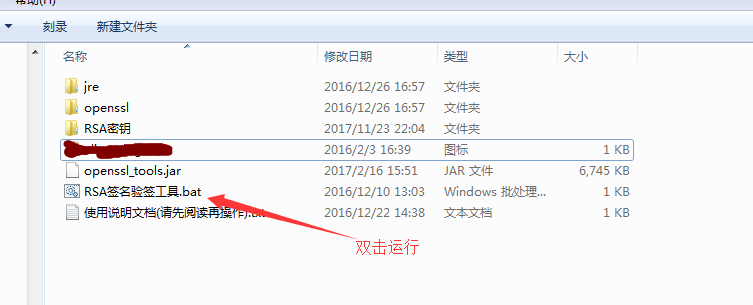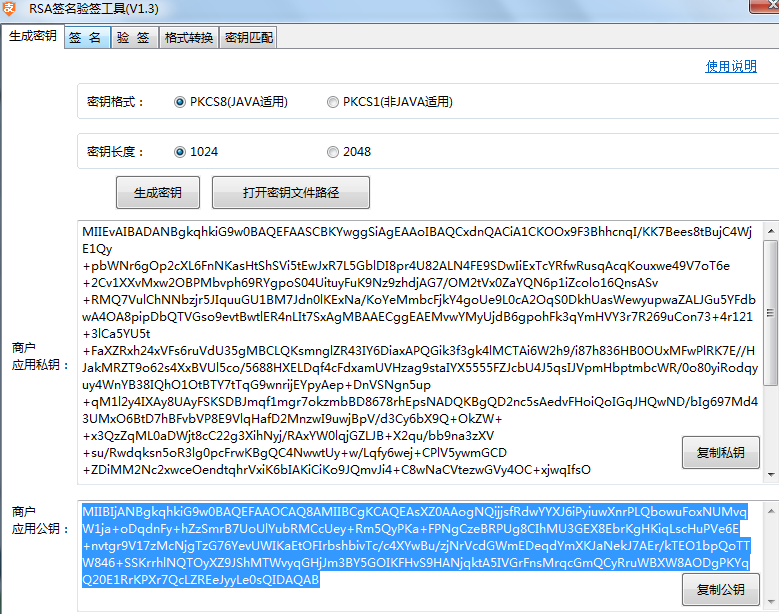RSA是非对称性加密算法, 在了解非对称性算法前,我们先了解一下对称算法
1.对称算法:
1976年以前,所有的加密方法都是同一种模式:
(1)甲方选择某一种加密规则,对信息进行加密;
(2)乙方使用同一种规则,对信息进行解密。
由于加密和解密使用同样规则(简称"密钥"),这被称为"对称加密算法"(Symmetric-key algorithm)。
这种加密模式有一个最大弱点:甲方必须把加密规则告诉乙方,否则无法解密。保存和传递密钥,就成了最头疼的问题
2.非对称性算法:
1976年,两位美国计算机学家Whitfield Diffie 和 Martin Hellman,提出了一种崭新构思,可以在不直接传递密钥的情况下,完成解密。这被称为"Diffie-Hellman密钥交换算法"。这个算法启发了其他科学家。人们认识到,加密和解密可以使用不同的规则,只要这两种规则之间存在某种对应关系即可,这样就避免了直接传递密钥。
这种新的加密模式被称为"非对称加密算法"。
(1)乙方生成两把密钥(公钥和私钥)。公钥是公开的,任何人都可以获得,私钥则是保密的。
(2)甲方获取乙方的公钥,然后用它对信息加密。
(3)乙方得到加密后的信息,用私钥解密。
如果公钥加密的信息只有私钥解得开,那么只要私钥不泄漏,通信就是安全的。
1977年,三位数学家Rivest、Shamir 和 Adleman 设计了一种算法,可以实现非对称加密。这种算法用他们三个人的名字命名,叫做RSA算法。从那时直到现在,RSA算法一直是最广为使用的"非对称加密算法"。毫不夸张地说,只要有计算机网络的地方,就有RSA算法。
这种算法非常可靠,密钥越长,它就越难破解。根据已经披露的文献,目前被破解的最长RSA密钥是768个二进制位。也就是说,长度超过768位的密钥,还无法破解(至少没人公开宣布)。因此可以认为,1024位的RSA密钥基本安全,2048位的密钥极其安全。
本文对应的demo中,有一个工具,可以利用其得到1024位的密钥, 也可以得到2048位的密钥(见下图)
本文只讲解1024位的加解密, 2048位的加解密其它篇幅会讲到(如果将2048位密钥放到下面的测试代码,会产生错误)


3. 加密,解密算法工具类
RSAUtils.java--RSA公钥/私钥/签名工具包
此工具类也可以根据算法生成上图对应工具生成的 公钥/私钥 组
package com.wisdomdd.rsa;
import java.io.ByteArrayOutputStream;
import java.security.Key;
import java.security.KeyFactory;
import java.security.KeyPair;
import java.security.KeyPairGenerator;
import java.security.PrivateKey;
import java.security.PublicKey;
import java.security.Signature;
import java.security.interfaces.RSAPrivateKey;
import java.security.interfaces.RSAPublicKey;
import java.security.spec.PKCS8EncodedKeySpec;
import java.security.spec.X509EncodedKeySpec;
import java.util.HashMap;
import java.util.Map;
import javax.crypto.Cipher;
/**
* <p>
* RSA公钥/私钥/签名工具包
* </p>
* <p>
* 罗纳德·李维斯特(Ron [R]ivest)、阿迪·萨莫尔(Adi [S]hamir)和伦纳德·阿德曼(Leonard [A]dleman)
* </p>
* <p>
* 字符串格式的密钥在未在特殊说明情况下都为BASE64编码格式<br/>
* 由于非对称加密速度极其缓慢,一般文件不使用它来加密而是使用对称加密,<br/>
* 非对称加密算法可以用来对对称加密的密钥加密,这样保证密钥的安全也就保证了数据的安全
* </p>
*
* @author IceWee
* @date 2012-4-26
* @version 1.0
*/
public class RSAUtils {
/**
* 加密算法RSA
*/
public static final String KEY_ALGORITHM = "RSA";
/**
* 签名算法
*/
public static final String SIGNATURE_ALGORITHM = "MD5withRSA";
/**
* 获取公钥的key
*/
private static final String PUBLIC_KEY = "RSAPublicKey";
/**
* 获取私钥的key
*/
private static final String PRIVATE_KEY = "RSAPrivateKey";
/**
* RSA最大加密明文大小
*/
private static final int MAX_ENCRYPT_BLOCK = 117;
/**
* RSA最大解密密文大小
*/
private static final int MAX_DECRYPT_BLOCK = 128;
/**
* <p>
* 生成密钥对(公钥和私钥)
* </p>
*
* @return
* @throws Exception
*/
public static Map<String, Object> genKeyPair() throws Exception {
KeyPairGenerator keyPairGen = KeyPairGenerator.getInstance(KEY_ALGORITHM);
keyPairGen.initialize(1024);
KeyPair keyPair = keyPairGen.generateKeyPair();
RSAPublicKey publicKey = (RSAPublicKey) keyPair.getPublic();
RSAPrivateKey privateKey = (RSAPrivateKey) keyPair.getPrivate();
Map<String, Object> keyMap = new HashMap<String, Object>(2);
keyMap.put(PUBLIC_KEY, publicKey);
keyMap.put(PRIVATE_KEY, privateKey);
return keyMap;
}
/**
* <p>
* 用私钥对信息生成数字签名
* </p>
*
* @param data 已加密数据
* @param privateKey 私钥(BASE64编码)
*
* @return
* @throws Exception
*/
public static String sign(byte[] data, String privateKey) throws Exception {
byte[] keyBytes = Base64Utils.decode(privateKey);
PKCS8EncodedKeySpec pkcs8KeySpec = new PKCS8EncodedKeySpec(keyBytes);
KeyFactory keyFactory = KeyFactory.getInstance(KEY_ALGORITHM);
PrivateKey privateK = keyFactory.generatePrivate(pkcs8KeySpec);
Signature signature = Signature.getInstance(SIGNATURE_ALGORITHM);
signature.initSign(privateK);
signature.update(data);
return Base64Utils.encode(signature.sign());
}
/**
* <p>
* 校验数字签名
* </p>
*
* @param data 已加密数据
* @param publicKey 公钥(BASE64编码)
* @param sign 数字签名
*
* @return
* @throws Exception
*
*/
public static boolean verify(byte[] data, String publicKey, String sign)
throws Exception {
byte[] keyBytes = Base64Utils.decode(publicKey);
X509EncodedKeySpec keySpec = new X509EncodedKeySpec(keyBytes);
KeyFactory keyFactory = KeyFactory.getInstance(KEY_ALGORITHM);
PublicKey publicK = keyFactory.generatePublic(keySpec);
Signature signature = Signature.getInstance(SIGNATURE_ALGORITHM);
signature.initVerify(publicK);
signature.update(data);
return signature.verify(Base64Utils.decode(sign));
}
/**
* <P>
* 私钥解密
* </p>
*
* @param encryptedData 已加密数据
* @param privateKey 私钥(BASE64编码)
* @return
* @throws Exception
*/
public static byte[] decryptByPrivateKey(byte[] encryptedData, String privateKey)
throws Exception {
byte[] keyBytes = Base64Utils.decode(privateKey);
PKCS8EncodedKeySpec pkcs8KeySpec = new PKCS8EncodedKeySpec(keyBytes);
KeyFactory keyFactory = KeyFactory.getInstance(KEY_ALGORITHM);
Key privateK = keyFactory.generatePrivate(pkcs8KeySpec);
Cipher cipher = Cipher.getInstance(keyFactory.getAlgorithm());
cipher.init(Cipher.DECRYPT_MODE, privateK);
int inputLen = encryptedData.length;
ByteArrayOutputStream out = new ByteArrayOutputStream();
int offSet = 0;
byte[] cache;
int i = 0;
// 对数据分段解密
while (inputLen - offSet > 0) {
if (inputLen - offSet > MAX_DECRYPT_BLOCK) {
cache = cipher.doFinal(encryptedData, offSet, MAX_DECRYPT_BLOCK);
} else {
cache = cipher.doFinal(encryptedData, offSet, inputLen - offSet);
}
out.write(cache, 0, cache.length);
i++;
offSet = i * MAX_DECRYPT_BLOCK;
}
byte[] decryptedData = out.toByteArray();
out.close();
return decryptedData;
}
/**
* <p>
* 公钥解密
* </p>
*
* @param encryptedData 已加密数据
* @param publicKey 公钥(BASE64编码)
* @return
* @throws Exception
*/
public static byte[] decryptByPublicKey(byte[] encryptedData, String publicKey)
throws Exception {
byte[] keyBytes = Base64Utils.decode(publicKey);
X509EncodedKeySpec x509KeySpec = new X509EncodedKeySpec(keyBytes);
KeyFactory keyFactory = KeyFactory.getInstance(KEY_ALGORITHM);
Key publicK = keyFactory.generatePublic(x509KeySpec);
Cipher cipher = Cipher.getInstance(keyFactory.getAlgorithm());
cipher.init(Cipher.DECRYPT_MODE, publicK);
int inputLen = encryptedData.length;
ByteArrayOutputStream out = new ByteArrayOutputStream();
int offSet = 0;
byte[] cache;
int i = 0;
// 对数据分段解密
while (inputLen - offSet > 0) {
if (inputLen - offSet > MAX_DECRYPT_BLOCK) {
cache = cipher.doFinal(encryptedData, offSet, MAX_DECRYPT_BLOCK);
} else {
cache = cipher.doFinal(encryptedData, offSet, inputLen - offSet);
}
out.write(cache, 0, cache.length);
i++;
offSet = i * MAX_DECRYPT_BLOCK;
}
byte[] decryptedData = out.toByteArray();
out.close();
return decryptedData;
}
/**
* <p>
* 公钥加密
* </p>
*
* @param data 源数据
* @param publicKey 公钥(BASE64编码)
* @return
* @throws Exception
*/
public static byte[] encryptByPublicKey(byte[] data, String publicKey)
throws Exception {
byte[] keyBytes = Base64Utils.decode(publicKey);
X509EncodedKeySpec x509KeySpec = new X509EncodedKeySpec(keyBytes);
KeyFactory keyFactory = KeyFactory.getInstance(KEY_ALGORITHM);
Key publicK = keyFactory.generatePublic(x509KeySpec);
// 对数据加密
Cipher cipher = Cipher.getInstance(keyFactory.getAlgorithm());
cipher.init(Cipher.ENCRYPT_MODE, publicK);
int inputLen = data.length;
ByteArrayOutputStream out = new ByteArrayOutputStream();
int offSet = 0;
byte[] cache;
int i = 0;
// 对数据分段加密
while (inputLen - offSet > 0) {
if (inputLen - offSet > MAX_ENCRYPT_BLOCK) {
cache = cipher.doFinal(data, offSet, MAX_ENCRYPT_BLOCK);
} else {
cache = cipher.doFinal(data, offSet, inputLen - offSet);
}
out.write(cache, 0, cache.length);
i++;
offSet = i * MAX_ENCRYPT_BLOCK;
}
byte[] encryptedData = out.toByteArray();
out.close();
return encryptedData;
}
/**
* <p>
* 私钥加密
* </p>
*
* @param data 源数据
* @param privateKey 私钥(BASE64编码)
* @return
* @throws Exception
*/
public static byte[] encryptByPrivateKey(byte[] data, String privateKey)
throws Exception {
byte[] keyBytes = Base64Utils.decode(privateKey);
PKCS8EncodedKeySpec pkcs8KeySpec = new PKCS8EncodedKeySpec(keyBytes);
KeyFactory keyFactory = KeyFactory.getInstance(KEY_ALGORITHM);
Key privateK = keyFactory.generatePrivate(pkcs8KeySpec);
Cipher cipher = Cipher.getInstance(keyFactory.getAlgorithm());
cipher.init(Cipher.ENCRYPT_MODE, privateK);
int inputLen = data.length;
ByteArrayOutputStream out = new ByteArrayOutputStream();
int offSet = 0;
byte[] cache;
int i = 0;
// 对数据分段加密
while (inputLen - offSet > 0) {
if (inputLen - offSet > MAX_ENCRYPT_BLOCK) {
cache = cipher.doFinal(data, offSet, MAX_ENCRYPT_BLOCK);
} else {
cache = cipher.doFinal(data, offSet, inputLen - offSet);
}
out.write(cache, 0, cache.length);
i++;
offSet = i * MAX_ENCRYPT_BLOCK;
}
byte[] encryptedData = out.toByteArray();
out.close();
return encryptedData;
}
/**
* <p>
* 获取私钥
* </p>
*
* @param keyMap 密钥对
* @return
* @throws Exception
*/
public static String getPrivateKey(Map<String, Object> keyMap)
throws Exception {
Key key = (Key) keyMap.get(PRIVATE_KEY);
return Base64Utils.encode(key.getEncoded());
}
/**
* <p>
* 获取公钥
* </p>
*
* @param keyMap 密钥对
* @return
* @throws Exception
*/
public static String getPublicKey(Map<String, Object> keyMap)
throws Exception {
Key key = (Key) keyMap.get(PUBLIC_KEY);
return Base64Utils.encode(key.getEncoded());
}
}上面代码使用到了Base64加密,下面提供 Base64Utils的代码
Base64Utils.java--BASE64编码解码工具包
该工具类中用到了BASE64,需要借助第三方类库:javabase64-1.3.1.jar
package com.wisdomdd.rsa;
import java.io.ByteArrayInputStream;
import java.io.ByteArrayOutputStream;
import java.io.File;
import java.io.FileInputStream;
import java.io.FileOutputStream;
import java.io.InputStream;
import java.io.OutputStream;
import it.sauronsoftware.base64.Base64;
/**
* <p>
* BASE64编码解码工具包
* </p>
* <p>
* 依赖javabase64-1.3.1.jar
* </p>
*
* @author IceWee
* @date 2012-5-19
* @version 1.0
*/
public class Base64Utils {
/**
* 文件读取缓冲区大小
*/
private static final int CACHE_SIZE = 1024;
/**
* <p>
* BASE64字符串解码为二进制数据
* </p>
*
* @param base64
* @return
* @throws Exception
*/
public static byte[] decode(String base64) throws Exception {
return Base64.decode(base64.getBytes());
}
/**
* <p>
* 二进制数据编码为BASE64字符串
* </p>
*
* @param bytes
* @return
* @throws Exception
*/
public static String encode(byte[] bytes) throws Exception {
return new String(Base64.encode(bytes));
}
/**
* <p>
* 将文件编码为BASE64字符串
* </p>
* <p>
* 大文件慎用,可能会导致内存溢出
* </p>
*
* @param filePath
* 文件绝对路径
* @return
* @throws Exception
*/
public static String encodeFile(String filePath) throws Exception {
byte[] bytes = fileToByte(filePath);
return encode(bytes);
}
/**
* <p>
* BASE64字符串转回文件
* </p>
*
* @param filePath
* 文件绝对路径
* @param base64
* 编码字符串
* @throws Exception
*/
public static void decodeToFile(String filePath, String base64) throws Exception {
byte[] bytes = decode(base64);
byteArrayToFile(bytes, filePath);
}
/**
* <p>
* 文件转换为二进制数组
* </p>
*
* @param filePath
* 文件路径
* @return
* @throws Exception
*/
public static byte[] fileToByte(String filePath) throws Exception {
byte[] data = new byte[0];
File file = new File(filePath);
if (file.exists()) {
FileInputStream in = new FileInputStream(file);
ByteArrayOutputStream out = new ByteArrayOutputStream(2048);
byte[] cache = new byte[CACHE_SIZE];
int nRead = 0;
while ((nRead = in.read(cache)) != -1) {
out.write(cache, 0, nRead);
out.flush();
}
out.close();
in.close();
data = out.toByteArray();
}
return data;
}
/**
* <p>
* 二进制数据写文件
* </p>
*
* @param bytes
* 二进制数据
* @param filePath
* 文件生成目录
*/
public static void byteArrayToFile(byte[] bytes, String filePath) throws Exception {
InputStream in = new ByteArrayInputStream(bytes);
File destFile = new File(filePath);
if (!destFile.getParentFile().exists()) {
destFile.getParentFile().mkdirs();
}
destFile.createNewFile();
OutputStream out = new FileOutputStream(destFile);
byte[] cache = new byte[CACHE_SIZE];
int nRead = 0;
while ((nRead = in.read(cache)) != -1) {
out.write(cache, 0, nRead);
out.flush();
}
out.close();
in.close();
}
}上面提供了RSA工具类的代码,
下面使用示例代码讲解 加密/解密 示例代码
--这里使用代码获得公钥私钥,也可以使用工具获得配对的公钥私钥
Map<String, Object> keyMap = RSAUtils.genKeyPair();
String publicKey = RSAUtils.getPublicKey(keyMap); ----获得RSA公钥
String privateKey = RSAUtils.getPrivateKey(keyMap); ----获得RSA私钥
RSAUtils.encryptByPrivateKey(data, publicKey); ----私钥加密
RSAUtils.decryptByPublicKey(encodedData, privateKey); ----公钥解密
RSAUtils.encryptByPublicKey(data, publicKey); ----公钥加密
RSAUtils.decryptByPrivateKey(encodedData, privateKey); ----私钥解密
package com.wisdomdd.rsa;
import java.util.Map;
public class RSATester {
static String publicKey;
static String privateKey;
static {
try {
Map<String, Object> keyMap = RSAUtils.genKeyPair();
publicKey = RSAUtils.getPublicKey(keyMap);
privateKey = RSAUtils.getPrivateKey(keyMap);
System.err.println("公钥: \n\r" + publicKey);
System.err.println("私钥: \n\r" + privateKey);
} catch (Exception e) {
e.printStackTrace();
}
}
public static void main(String[] args) throws Exception {
test();
//testSign();
//testHttpSign();
}
static void test() throws Exception {
System.err.println("公钥加密——私钥解密");
String source = "这是一行没有任何意义的文字,你看完了等于没看,不是吗?";
System.out.println("\r加密前文字:\r\n" + source);
byte[] data = source.getBytes();
byte[] encodedData = RSAUtils.encryptByPublicKey(data, publicKey);
System.out.println("加密后文字:\r\n" + new String(encodedData));
byte[] decodedData = RSAUtils.decryptByPrivateKey(encodedData, privateKey);
String target = new String(decodedData);
System.out.println("解密后文字: \r\n" + target);
String sign = RSAUtils.sign(encodedData, privateKey);
boolean status = RSAUtils.verify(encodedData, publicKey, sign);
System.err.println("验证结果:\r" + status);
}
static void testSign() throws Exception {
System.err.println("私钥加密——公钥解密");
String source = "这是一行测试RSA数字签名的无意义文字";
System.out.println("原文字:\r\n" + source);
byte[] data = source.getBytes();
byte[] encodedData = RSAUtils.encryptByPrivateKey(data, privateKey);
System.out.println("加密后:\r\n" + new String(encodedData));
byte[] decodedData = RSAUtils.decryptByPublicKey(encodedData, publicKey);
String target = new String(decodedData);
System.out.println("解密后: \r\n" + target);
System.err.println("私钥签名——公钥验证签名");
String sign = RSAUtils.sign(encodedData, privateKey);
System.err.println("签名:\r" + sign);
boolean status = RSAUtils.verify(encodedData, publicKey, sign);
System.err.println("验证结果:\r" + status);
}
static void testHttpSign() throws Exception {
String param = "id=1&name=张三";
byte[] encodedData = RSAUtils.encryptByPrivateKey(param.getBytes(), privateKey);
System.out.println("加密后:" + encodedData);
byte[] decodedData = RSAUtils.decryptByPublicKey(encodedData, publicKey);
System.out.println("解密后:" + new String(decodedData));
String sign = RSAUtils.sign(encodedData, privateKey);
System.err.println("签名:" + sign);
boolean status = RSAUtils.verify(encodedData, publicKey, sign);
System.err.println("签名验证结果:" + status);
}
} 下载Demo
下载Demo